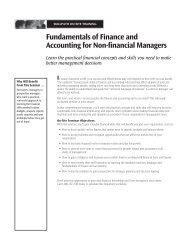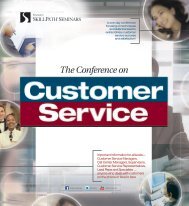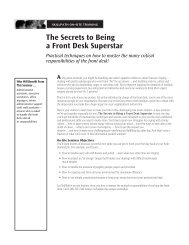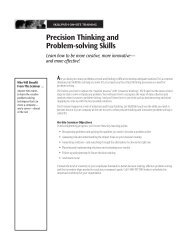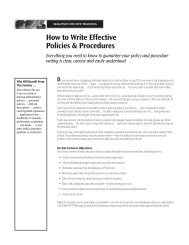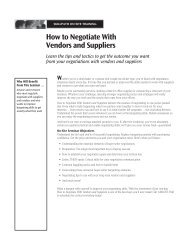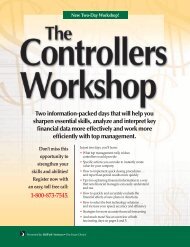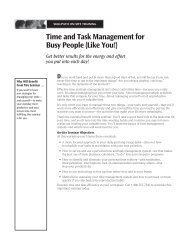30-hour Outreach Training Compliance Course - SkillPath | Seminars
30-hour Outreach Training Compliance Course - SkillPath | Seminars
30-hour Outreach Training Compliance Course - SkillPath | Seminars
Create successful ePaper yourself
Turn your PDF publications into a flip-book with our unique Google optimized e-Paper software.
OSHA<br />
Program <strong>hour</strong>s: 9:00 a.m. to 4:00 p.m. each day<br />
Your Comprehensive Five-day Agenda<br />
4<br />
DAY ONE<br />
■ Understanding today’s OSHA<br />
■ Rights and responsibilities—yours and<br />
your employees’<br />
■ How to file a complaint<br />
■ Resources to help you stay in compliance<br />
■ OSHA’s “catch-all” regulation: The General<br />
Duty Clause<br />
■ The many benefits of a job hazard analysis<br />
■ The link between management commitment and<br />
employee involvement<br />
■ Creating your injury/illness prevention program<br />
■ Conducting job site inspections<br />
■ What a thorough worksite analysis is—and<br />
what it can reveal<br />
■ Investigating and preventing accidents<br />
■ Action steps for hazard prevention and control<br />
■ Why safety meetings are worth it<br />
■ How good supervisory communication<br />
improves safety<br />
■ Industrial hygiene and OSHA compliance<br />
DAY TWO<br />
■ OSHA’s new rules and how they impact you<br />
■ An inside look at an OSHA inspection<br />
■ 5 ways to trigger an OSHA inspection<br />
■ Types of OSHA citations/fines<br />
■ Your options should you disagree with<br />
OSHA’s citation<br />
■ How Cal/OSHA is different from OSHA<br />
■ States with OSHA plans—is yours one<br />
■ Self-inspection checklist<br />
■ Are you required to admit an OSHA inspector<br />
■ Hot spots in your workplace the inspector will<br />
head straight for<br />
DAY THREE<br />
■ OSHA’s standards—basics you need to know<br />
■ OSHA’s record-keeping requirements in<br />
plain English<br />
■ Why sloppy record keeping is so dangerous<br />
■ 7 common record-keeping mistakes<br />
■ Where to keep records and for how long<br />
■ How to correctly fill out Forms <strong>30</strong>0, <strong>30</strong>0A and <strong>30</strong>1<br />
■ OSHA’s strict regulations on exit routes<br />
■ The minimum elements of a fire prevention plan<br />
■ Protecting employees from fire hazards<br />
■ Creating—and following—your emergency<br />
action plan<br />
■ How injury/illness records can be used against<br />
you in court<br />
■ What you must post and when<br />
■ BONUS: Samples of Forms <strong>30</strong>0, <strong>30</strong>0A and <strong>30</strong>1<br />
DAY FOUR<br />
■ A guide to OSHA’s often misunderstood Hazard<br />
Communication Standard<br />
■ Using and managing Material Safety Data Sheets<br />
■ Creating a chemical inventory<br />
■ Labeling your containers<br />
■ Making sure your Personal Protective Equipment<br />
practices measure up, including:<br />
• Safety glasses and hard hats<br />
• Gloves and hearing protection<br />
• Respirators<br />
■ 6 fall prevention best practices<br />
■ OSHA-compliant ladder and stair safety practices<br />
■ Walking and working surfaces, including:<br />
• Housekeeping and aisleways<br />
• Floor load protection, wall openings and holes<br />
• Stairways and platforms



